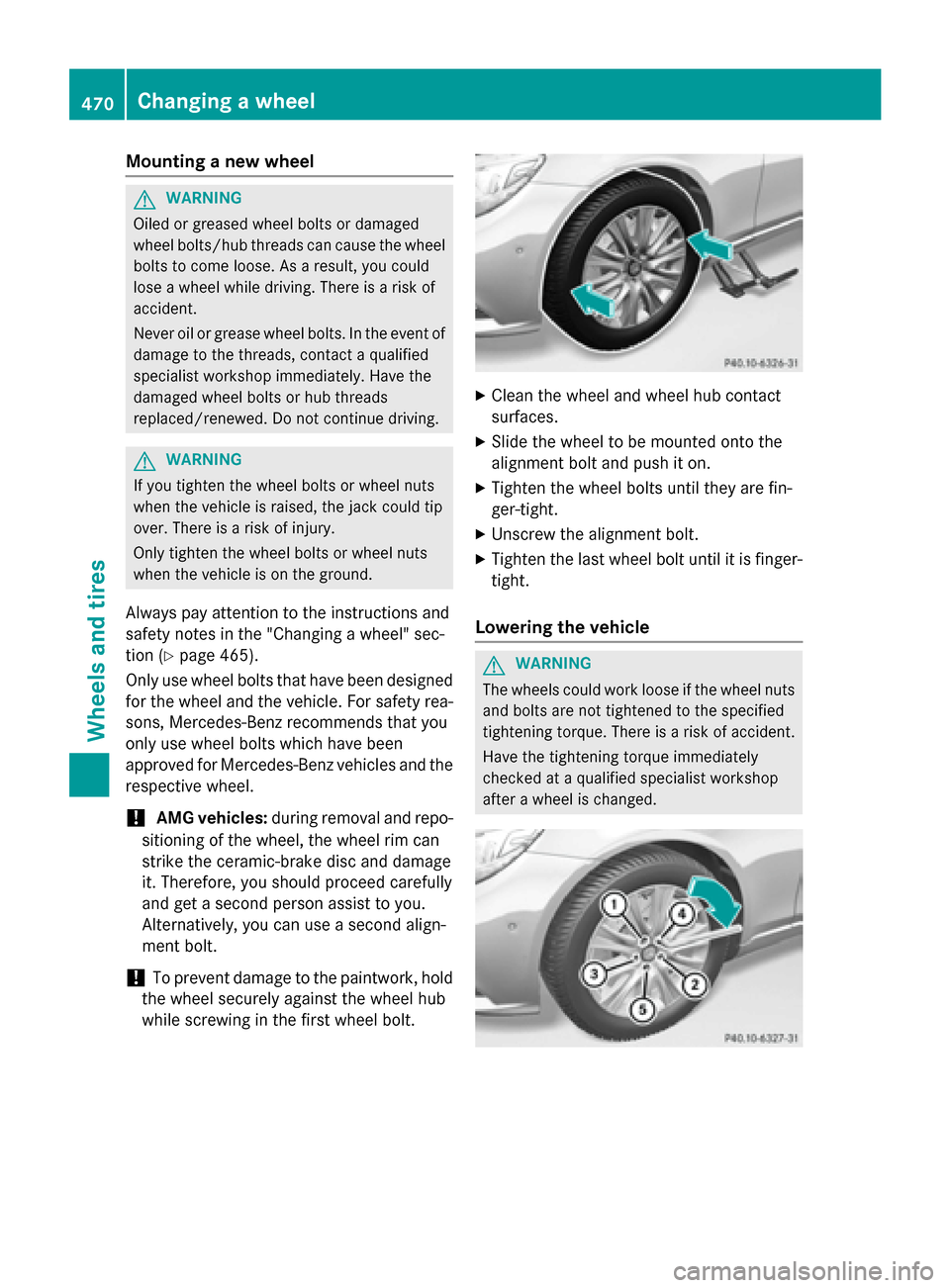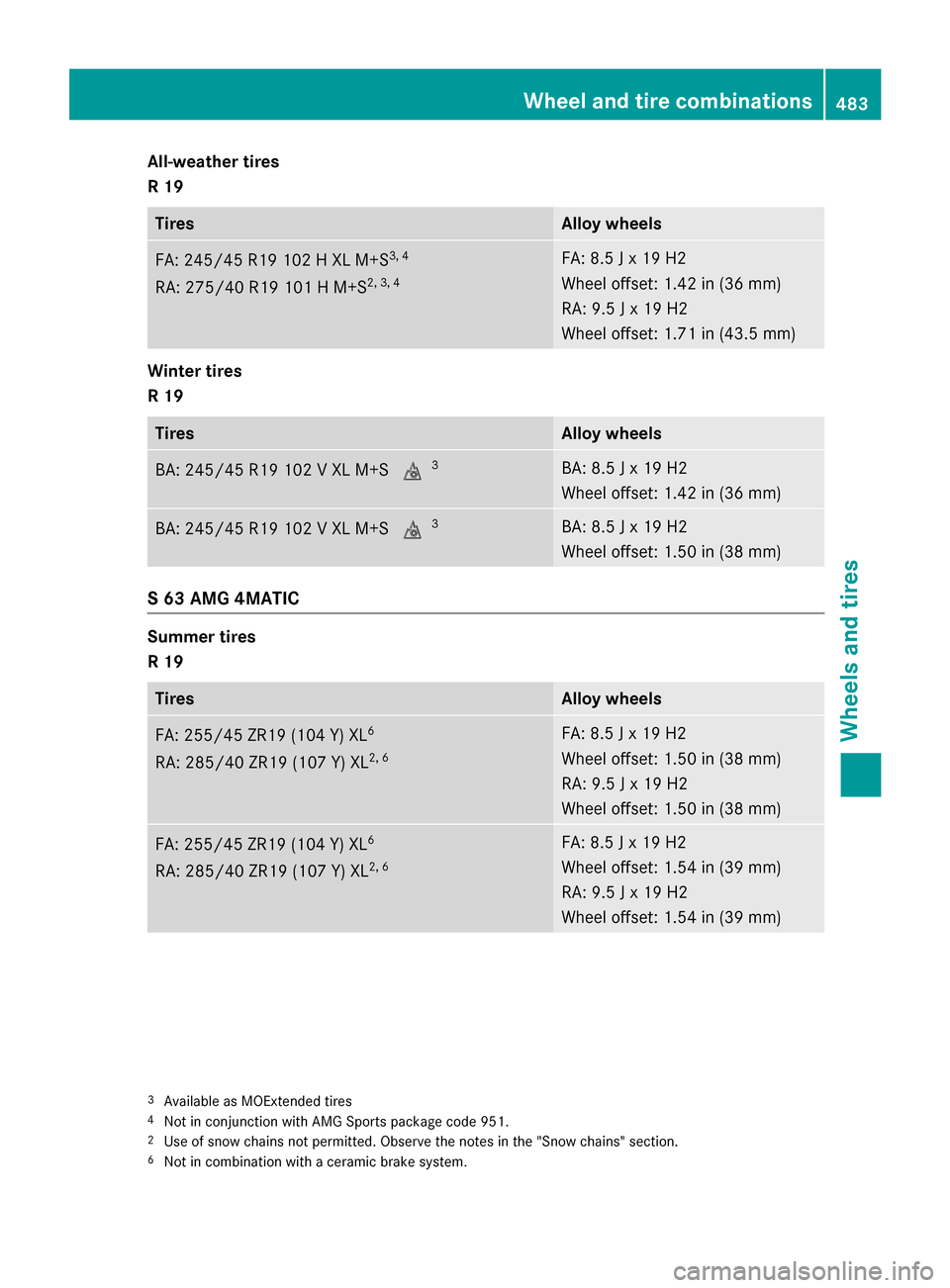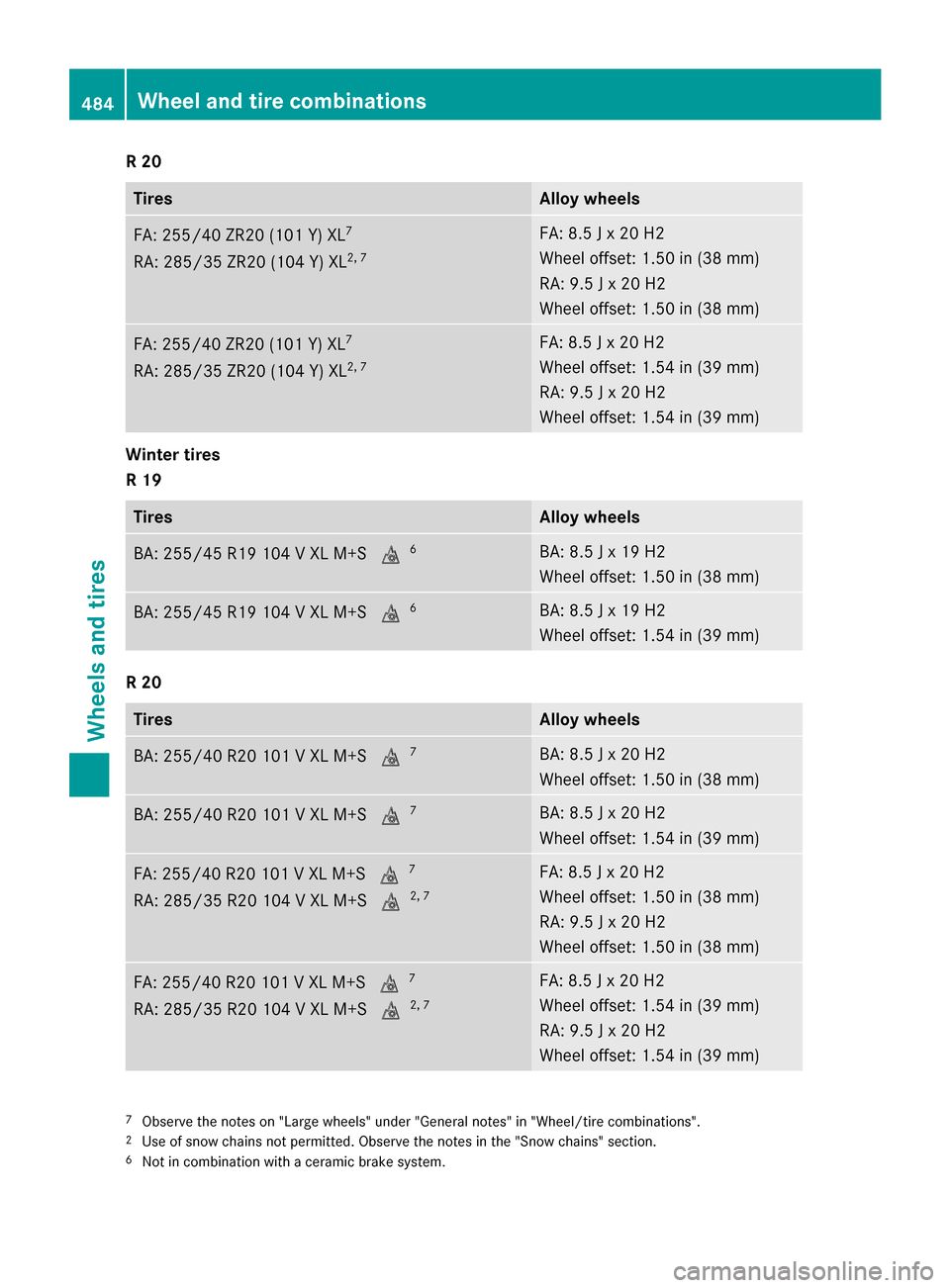2015 MERCEDES-BENZ S-Class brake
[x] Cancel search: brakePage 468 of 502

Rotate the wheels before a clear wear pattern
has formed on the tires. Front tires typically
wear more on the shoulders and the rear tires in the center.
If your vehicle's tire configuration allows, you
can rotate the wheels according to the inter-
vals in the tire manufacturer's warranty book in your vehicle documents. If no warranty
book is available, the tires should be rotated
every 3,000 to 6,000 miles (5,000 to
10,000 km), or earlier if tire wear requires.
Ensure the direction of rotation is maintained.
Clean the contact surfaces of the wheel and
the brake disc thoroughly every time a wheel
is rotated. Check the tire pressure and, if nec- essary, restart the tire pressure loss warningsystem (Y page 452) or the tire pressure
monitor (Y page 451). Direction of rotation
Tires with a specified direction of rotation
have additional benefits, e.g. if there is a risk of hydroplaning. These advantages can only
be gained if the tires are installed correspond-
ing to the direction of rotation.
An arrow on the sidewall of the tire indicates its correct direction of rotation. Storing wheels
Store wheels that are not being used in a cool, dry and preferably dark place. Protect the
tires from oil, grease, gasoline and diesel. Mounting a wheel
Preparing the vehicle X
Stop the vehicle on solid, non-slippery and
level ground.
X Apply the electric parking brake manually.
X Bring the front wheels into the straight-
ahead position.
X Shift the transmission to position P.X
Make sure that "normal" level is selected
for AIRMATIC (Y page 246).
X Switch off the engine.
X Open the driver's door.
The on-board electronics now have status
0. This is the same as the SmartKey having
been removed.
X Remove Start/Stop button from ignition
lock (Y page 189).
or, if the SmartKey is inserted in the ignition
lock:
X Remove the SmartKey from the ignition
lock.
X If included in the vehicle equipment,
remove the tire-change tool kit from the
vehicle.
X Secure the vehicle to prevent it from rolling
away.
Securing the vehicle to prevent it from
rolling away If your vehicle is equipped with a wheel chock,
it can be found in the tire-change tool kit
(Y page 422).
The folding wheel chock is an additional
safety measure to prevent the vehicle from
rolling away, for example when changing a
wheel.
X Fold both plates upwards :.
X Fold out lower plate ;.
X Guide the lugs on the lower plate fully into
the openings in base plate =.466
Changing a wheelWheels and
tires
Page 469 of 502

X
On level ground: place chocks or other
suitable items under the front and rear of
the wheel that is diagonally opposite the
wheel you wish to change. X
On light downhill gradients: place
chocks or other suitable items in front of
the wheels of the front and rear axle.
Raising the vehicle G
WARNING
If you do not position the jack correctly at the appropriate jacking point of the vehicle, the
jack could tip over with the vehicle raised.
There is a risk of injury.
Only position the jack at the appropriate jack-
ing point of the vehicle. The base of the jack
must be positioned vertically, directly under
the jacking point of the vehicle.
! The jack is designed exclusively for jack-
ing up the vehicle at the jacking points.
Otherwise, your vehicle could be damaged. Observe the following when raising the
vehicle:
R To raise the vehicle, only use the vehicle-
specific jack that has been tested and
approved by Mercedes-Benz. If used incor-
rectly, the jack could tip over with the vehi- cle raised.
R The jack is designed only to raise and hold
the vehicle for a short time while a wheel
is being changed. It is not suited for per-
forming maintenance work under the vehi- cle.
R Avoid changing the wheel on uphill and
downhill slopes.
R Before raising the vehicle, secure it from
rolling away by applying the parking brake
and inserting wheel chocks. Do not disen-
gage the parking brake while the vehicle is
raised.
R The jack must be placed on a firm, flat and
non-slip surface. On a loose surface, a
large, flat, load-bearing underlay must be
used. On a slippery surface, a non-slip
underlay must be used, e.g. rubber mats.
R Do not use wooden blocks or similar
objects as a jack underlay. Otherwise, the
jack will not be able to achieve its load-
bearing capacity due to the restricted
height.
R Make sure that the distance between the
underside of the tires and the ground does
not exceed 1.2 in (3 cm).
R Never place your hands and feet under the
raised vehicle.
R Do not lie under the vehicle.
R Do not start the engine when the vehicle is
raised.
R Do not open or close a door or the trunk lid
when the vehicle is raised.
R Make sure that no persons are present in
the vehicle when the vehicle is raised.
Vehicles with AMG wheels and hub caps:
the hub cap covers the wheel bolts. Before
you can unscrew the wheel bolts, you must Changing a wheel
467Wheels and tires Z
Page 471 of 502

X
Take the ratchet wrench out of the vehicle
tool kit and place it on the hexagon nut of
the jack so that the letters AUFare visible.
AMG vehicles and vehicles with AMG
equipment: to protect the vehicle body, the
vehicle has covers next to the jacking points
on the outer sills. X
AMG vehicles and vehicles with AMG
equipment: fold cover?upwards. X
Position jack Bat jacking point A. X
Make sure the foot of the jack is directly
beneath the jacking point. X
Turn ratchet wrench Cuntil jack Bsits
completely on jacking point Aand the
base of the jack lies evenly on the ground.
X Turn ratchet wrench Cuntil the tire is
raised a maximum of 1.2 in (3 cm) from the ground.
Removing a wheel !
AMG vehicles:
during removal and repo-
sitioning of the wheel, the wheel rim can
strike the ceramic-brake disc and damage
it. Therefore, you should proceed carefully
and get a second person assist to you.
Alternatively, you can use a second align-
ment bolt.
! Do not place wheel bolts in sand or on a
dirty surface. The bolt and wheel hub
threads could otherwise be damaged when you screw them in.
When mounting/removing wheels, and for as
long as the wheels are removed, avoid apply- ing any external force on the brake disks. This could impair the level of comfort when brak-
ing. X
Unscrew the uppermost wheel bolt com-
pletely.
X Screw alignment bolt :into the thread
instead of the wheel bolt.
X Unscrew the remaining wheel bolts fully.
X Remove the wheel. Changing a wheel
469Wheels and tires Z
Page 472 of 502

Mounting a new wheel
G
WARNING
Oiled or greased wheel bolts or damaged
wheel bolts/hub threads can cause the wheel bolts to come loose. As a result, you could
lose a wheel while driving. There is a risk of
accident.
Never oil or grease wheel bolts. In the event of damage to the threads, contact a qualified
specialist workshop immediately. Have the
damaged wheel bolts or hub threads
replaced/renewed. Do not continue driving. G
WARNING
If you tighten the wheel bolts or wheel nuts
when the vehicle is raised, the jack could tip
over. There is a risk of injury.
Only tighten the wheel bolts or wheel nuts
when the vehicle is on the ground.
Always pay attention to the instructions and
safety notes in the "Changing a wheel" sec-
tion (Y page 465).
Only use wheel bolts that have been designed for the wheel and the vehicle. For safety rea-
sons, Mercedes-Benz recommends that you
only use wheel bolts which have been
approved for Mercedes-Benz vehicles and the
respective wheel.
! AMG vehicles:
during removal and repo-
sitioning of the wheel, the wheel rim can
strike the ceramic-brake disc and damage
it. Therefore, you should proceed carefully
and get a second person assist to you.
Alternatively, you can use a second align-
ment bolt.
! To prevent damage to the paintwork, hold
the wheel securely against the wheel hub
while screwing in the first wheel bolt. X
Clean the wheel and wheel hub contact
surfaces.
X Slide the wheel to be mounted onto the
alignment bolt and push it on.
X Tighten the wheel bolts until they are fin-
ger-tight.
X Unscrew the alignment bolt.
X Tighten the last wheel bolt until it is finger-
tight.
Lowering the vehicle G
WARNING
The wheels could work loose if the wheel nuts and bolts are not tightened to the specified
tightening torque. There is a risk of accident.
Have the tightening torque immediately
checked at a qualified specialist workshop
after a wheel is changed. 470
Changing a wheelWheels and tires
Page 485 of 502

All-weather tires
R 19
Tires Alloy wheels
FA: 245/45 R19 102 H XL M+S
3, 4
RA: 275/40 R19 101 H M+S 2, 3, 4 FA: 8.5 J x 19 H2
Wheel offset: 1.42 in (36 mm)
RA: 9.5 J x 19 H2
Wheel offset: 1.71 in (43.5 mm)
Winter tires
R 19
Tires Alloy wheels
BA: 245/45 R19 102 V XL M+S
i3 BA: 8.5 J x 19 H2
Wheel offset: 1.42 in (36 mm)
BA: 245/45 R19 102 V XL M+S
i3 BA: 8.5 J x 19 H2
Wheel offset: 1.50 in (38 mm)
S 63 AMG 4MATIC
Summer tires
R 19
Tires Alloy wheels
FA: 255/45 ZR19 (104 Y) XL
6
RA: 285/40 ZR19 (107 Y) XL 2, 6 FA: 8.5 J x 19 H2
Wheel offset: 1.50 in (38 mm)
RA: 9.5 J x 19 H2
Wheel offset: 1.50 in (38 mm)
FA: 255/45 ZR19 (104 Y) XL
6
RA: 285/40 ZR19 (107 Y) XL 2, 6 FA: 8.5 J x 19 H2
Wheel offset: 1.54 in (39 mm)
RA: 9.5 J x 19 H2
Wheel offset: 1.54 in (39 mm)
3
Available as MOExtended tires
4 Not in conjunction with AMG Sports package code 951.
2 Use of snow chains not permitted. Observe the notes in the "Snow chains" section.
6 Not in combination with a ceramic brake system. Wheel and tire combinations
483Wheels and tires Z
Page 486 of 502

R 20
Tires Alloy wheels
FA: 255/40 ZR20 (101 Y) XL
7
RA: 285/35 ZR20 (104 Y) XL 2, 7 FA: 8.5 J x 20 H2
Wheel offset: 1.50 in (38 mm)
RA: 9.5 J x 20 H2
Wheel offset: 1.50 in (38 mm)
FA: 255/40 ZR20 (101 Y) XL
7
RA: 285/35 ZR20 (104 Y) XL 2, 7 FA: 8.5 J x 20 H2
Wheel offset: 1.54 in (39 mm)
RA: 9.5 J x 20 H2
Wheel offset: 1.54 in (39 mm)
Winter tires
R 19
Tires Alloy wheels
BA: 255/45 R19 104 V XL M+S
i6 BA: 8.5 J x 19 H2
Wheel offset: 1.50 in (38 mm)
BA: 255/45 R19 104 V XL M+S
i6 BA: 8.5 J x 19 H2
Wheel offset: 1.54 in (39 mm)
R 20
Tires Alloy wheels
BA: 255/40 R20 101 V XL M+S
i7 BA: 8.5 J x 20 H2
Wheel offset: 1.50 in (38 mm)
BA: 255/40 R20 101 V XL M+S
i7 BA: 8.5 J x 20 H2
Wheel offset: 1.54 in (39 mm)
FA: 255/40 R20 101 V XL M+S
i7
RA: 285/35 R20 104 V XL M+S i2, 7 FA: 8.5 J x 20 H2
Wheel offset: 1.50 in (38 mm)
RA: 9.5 J x 20 H2
Wheel offset: 1.50 in (38 mm)
FA: 255/40 R20 101 V XL M+S
i7
RA: 285/35 R20 104 V XL M+S i2, 7 FA: 8.5 J x 20 H2
Wheel offset: 1.54 in (39 mm)
RA: 9.5 J x 20 H2
Wheel offset: 1.54 in (39 mm)
7
Observe the notes on "Large wheels" under "General notes" in "Wheel/tire combinations".
2 Use of snow chains not permitted. Observe the notes in the "Snow chains" section.
6 Not in combination with a ceramic brake system. 484
Wheel and tire combinationsWheels and tires
Page 491 of 502

Vehicle identification plate with vehi-
cle identification number (VIN) X
Open the front right-hand door.
X Fold cover :down and remove it.
You will see the VIN.
The VIN can also be found in the following
locations:
R on the lower edge of the windshield
(Y page 489)
R on the vehicle identification plate
(Y page 488) Engine number
:
Engine number (stamped into the crank-
case)
; VIN (on the lower edge of the windshield)
= Emission control information plate,
including the certification of both federal
and Californian emissions standards Service products and filling capaci-
ties
Important safety notes
G
WARNING
Service products may be poisonous and haz-
ardous to health. There is a risk of injury.
Comply with instructions on the use, storage
and disposal of service products on the labels of the respective original containers. Always
store service products sealed in their original containers. Always keep service products out
of the reach of children. H
Environmental note
Dispose of service products in an environ-
mentally responsible manner.
Service products include the following:
R Fuels
R Lubricants (e.g. engine oil, transmission oil)
R Coolant
R Brake fluid
R Windshield washer fluid
R Climate control system refrigerant
Components and service products must be
matched. Only use products recommended
by Mercedes-Benz. Damage which is caused
by the use of products which have not been
recommended is not covered by the
Mercedes-Benz warranty or goodwill ges-
tures. They are listed in this Mercedes-Benz
Operator's Manual in the appropriate section.
Information on tested and approved products can be obtained at an authorized Mercedes-
Benz Center or on the Internet at
http://bevo.mercedes-benz.com.
You can recognize service products approved
by Mercedes-Benz by the following inscrip-
tion on the containers:
R MB-Freigabe (e.g. MB-Freigabe 229.51)
R MB Approval (e.g. MB Approval 229.51)
Other designations or recommendations indi- cate a level of quality or a specification in Service products and filling capacities
489Technical data Z
Page 494 of 502

The engine oils are matched to the perform-
ance of Mercedes-Benz engines and service
intervals. You should therefore only use
engine oils and oil filters that are approved for vehicles with maintenance systems.
For a list of approved engine oils and oil filters,
consult an authorized Mercedes-Benz Cen-
ter. Or visit the website
http://bevo.mercedes-benz.com.
The table shows which engine oils have been
approved for your vehicle. Model Engine
model MB
Approval S 400 4MATIC
S 550 PLUG-IN
HYBRID
276 229.5
AMG vehicles
157
279 229.5
All other models
277
278 229.5
i
MB approval is indicated on the oil con-
tainers.
Filling capacities The following values refer to an oil change
including the oil filter.
Model Capacity
S 400 4MATIC
S 550 PLUG-IN
HYBRID
6.9 US qt (6.5
l) S 600
S 600 MAYBACH
11.1 US qt (10.5
l) S 65 AMG
11.1 US qt (10.5
l) All ot
her AMG vehi-
cles 9.0 US qt (8.5
l) All ot
her models 8.5 US qt (8.0
l) Ad
ditives !
Do not use any additives in the engine oil.
This could damage the engine.
Engine oil viscosity Viscosity describes the flow characteristics
of a fluid. If an engine oil has a high viscosity,
this means that it is thick; a low viscosity
means that it is thin.
Select an engine oil with an SAE classification (viscosity) suitable for the prevailing outside
temperatures. The table shows you which
SAE classifications are to be used. The low-
temperature characteristics of engine oils
can deteriorate significantly, e.g. as a result
of aging, soot and fuel deposits. It is therefore
strongly recommended that you carry out reg- ular oil changes using an approved engine oil
with the appropriate SAE classification. Brake fluid
G
WARNING
The brake fluid constantly absorbs moisture
from the air. This lowers the boiling point of
the brake fluid. If the boiling point of the brake fluid is too low, vapor pockets may form in the brake system when the brakes are applied
hard. This would impair braking efficiency.
There is a risk of an accident.
You should have the brake fluid renewed at
the specified intervals. 492
Service products and filling capacitiesTechnical data